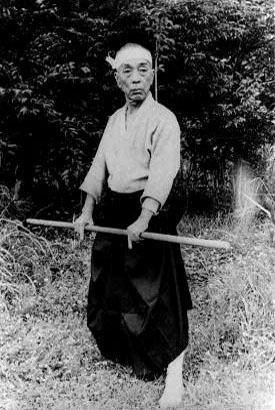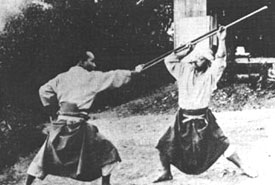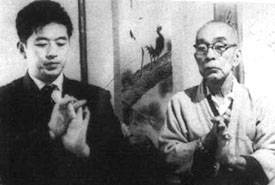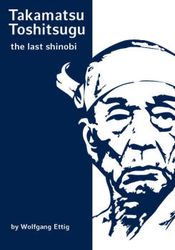Takamatsu Toshitsugu
Birth
Takamatsu Toshitsugu was born in the 22nd year of the Meiji Period, on March 10, 1889, in Akashi, Hyogo Province, Japan. His name was Hisatsugo, but he later changed it to Toshitsugu. As a child, he was called Jutaro.
Throughout his life, Takamatsu went by many names: Nakamushi (crybaby), Kikaku (demon horns), Kotora (little tiger), Moko no Tora (Mongolian tiger), and after his death, Bujin (divine warrior). His disciple Hatsumi Masaaki named the 9 traditions Bujinkan in his honor.
Takamatsu suffered from low blood pressure throughout his life, so he drank a glass of saltwater every day. He liked to paint in the morning, going to bed at 9 pm every day and getting up at 6:30 am, then rubbing himself down with a wet, ice-cold towel.
He ate three meals consisting of bean paste, sesame, vegetables, and buckwheat flour. He also ate a lot of small fish.
Takamatsu is said to have never done any warm-up exercises before training, even when fighting with real weapons. In a real fight you don’t have time to warm up either
he always said.
When he first saw judo on TV, he was said to have been indignant because they arched their backs during a technique in the sport.
Childhood
He was separated from his birth mother, Fushi, before he was even a year old, and had nine different foster mothers by the time he was twenty.
His father was Takamatsu Yasaburo, also known as Takamatsu Gishin. He often changed jobs, he was a salesman for Sanyo Railroad, later he owned a match factory in Kobe.
Takamatsu attended Akashi no Miya’s English School and later a Chinese formal school. He was a frail and self-pitying child, which is why he was nicknamed Crybaby.
Cruel Training with Master Toda
His father wanted him to be a strong warrior. Therefore, at the age of nine, at his father’s request, he began to study martial arts. He went to the Dōjō of his uncle Toda Shinryuken Masamitsu in Kobe, who also ran a chiropractic practice there. Toda was a Samurai from the Iga region whose ancestors were Ninja, but this only came out after Takamatsu’s death. He had been a sword instructor at a Tokugawa military school.

Toda didn’t teach Takamatsu any techniques, but pushed him around the Dōjō with his students and tried throws on him. Takamatsu vowed never to go to the Dōjō again but returned every night.
Every day he came home with bleeding elbows and knees. Takamatsu recalled feeling like a lamb going to the slaughterhouse
every day. But soon he grew stronger and gained weight.
After a year, Master Toda taught him the first techniques of the Shinden-fudo-Ryū. Toda realized that Takamatsu was very gifted at learning budo. At the age of thirteen, he mastered the Shinden-fudo-Ryū.
While he went to the Akashi no Miya’s English School in Kobe, he attended a Chinese educational school. Every other day he went to the Dōjō of Mizuta Yoshitaru Tadafusa and learned the Takagi-yōshin-Ryū jū tai jutsu.
At the same time, he learned from Toda the Togakure-Ryū ninpō, the Koto-Ryū koppō jutsu, the Gyokko-Ryū koshi jutsu, the Gyokushin-Ryū ninpō, and the Kumogakure-Ryū ninpō.
Takamatsu liked the Koto-Ryū, but he didn’t like the Togakure-Ryū. The Koto-Ryū strengthened the hands and feet, especially the fingers and toes. Through years of intense training, banging his hands against rocks and other hard objects, his fingernails and toenails were 4 to 5 millimeters thick, so he couldn’t cut them with regular nail scissors. He could use it to rip the bark off a tree. He later said that such weapons were no longer necessary today.
On a Sunday evening, Takamatsu was walking through the seaside park when he saw two children fighting with each other. One child was about 8, the other 12 or 13. At that moment 4 men appeared and helped the older child. When one of the men hit the child, Takamatsu intervened and moved against the men. He managed to evict all four.
He later learned that the men were professional Sumō fighters, and one was a fighter whom no one had yet defeated.
Takamatsu as Local Hero
At the age of thirteen, in a street brawl provoked by about 60 furyō (delinquent young people), he defeated ten of the 60 attackers and routed the rest. The attackers, some of whom were armed with swords, tried to force him and a friend to bow to the leader. Takamatsu knelt down, grabbed a rock, and smashed it on the leader’s foot. He fell to the ground and cried out loud. The others attacked Takamatsu. He managed to take out 5 to 8 attackers as the rest fled. The next day, a policeman came to his house and took him to the police station. He wanted to know how many others were there. The policeman did not want to believe that he had defeated the attackers alone, but the friend confirmed this and stated that he had not fought himself.
The next day the newspaper read: 13-year-old judō expert easily puts 60 gangsters to flight
.
The Sumō Match
At that time, Takamatsu was also a spectator at a Sumō wrestling match. A great fighter named Oni no Yama (Demon Mountain), who had defeated many fighters before, fought Raiden (Lightning). Oni no Yama simply knocked Raiden to the ground and threw him out of the ring. Takamatsu jumped up and entered the ring in his normal attire. When asked his name, he said his name was Akebono. Takamatsu defeated Oni no Yama and eight other men. Then a man who called himself Osakayama climbed into the ring. He was huge and weighed 112 kilograms. Takamatsu weighed only 59 kilograms. The two fought hard, but no matter how hard Takamatsu tried, he couldn’t move the heavy man. Osakayama grabbed his wrist and squeezed it hard. Takamatsu managed to throw Osakayama off balance, causing him to step out of the ring. The crowd cheered and tossed their seat cushions in the air.
The next day, Osakayama came to Takamatsu’s father and told him he was a professional Sumō wrestler from Osaka. He wanted to train his son to be a Sumō wrestler. But Takamatsu’s father refused because his son should become a soldier. It was only through the visit that he learned that his thirteen-year-old son had defeated a professional Sumō wrestler.
Fight Against Karate Students
At the age of fifteen, his master asked him to compete against two Musashi-Ryū karateka, aged 27 and 28. The first underrated Takamatsu and was defeated by a gyakunage.
The other fighter was warned and when Takamatsu tried to throw him, he hit his right ear and right arm as he fell, knocking Takamatsu out.
When the fighter learned that his opponent was only 15 years old, he was very impressed and said that he could not win against him again because Takamatsu now knew the secret technique of Musashi-Ryū (mushadori).
As a result of the battle, Takamatsu suffered hearing damage in his right ear throughout his life, which is why he was later not admitted to military school.
At the age of seventeen, he received the menkyōkaiden of Takagi-Ryū from his teacher Mizuta Yoshitaru Tadafusa. It was not uncommon at that time to give a student the menkyōkaiden early on to encourage them to try harder.
Training With Ishitani
That same year, Takamatsu met Ishitani Takakage Matsutaro, who worked as a bodyguard at his father’s match factory. Known throughout Japan as a famous fighter, Ishitani set up a small Dōjō at the factory and taught Takamatsu Kukishinden-Ryū happōhikenjutsu, Gikan-Ryū koppō jutsu, and several other aspects of Ninjutsu.
When Takamatsu was eighteen, he fetched 330 gallons (1 gallon = 4,546 liters) of freshwater for his father’s factory from a well every morning. The source was at the foot of Maruyama Mountain and 7 to 8 blocks from the factory. He had to fight five times, and each time he had to carry 240 kg of water home. This greatly strengthened his body.
The Night Attacker at the Bridge
One day a man from the factory told him someone had stopped him at Shinbashi Bridge last night. Whenever he evaded, the man blocked his path again. Finally, he grabbed it and threw it in the water.
During the following night, Takamatsu crossed the bridge several times without anything happening. He thought that the attacker might know him and disguised himself the next night. And as expected, a person blocked his way the next night. She wore a hat that hid her face. The attacker tried to throw Takamatsu, but couldn’t. He then tried to punch and kick him, but Takamatsu dodged the punches and kicks. When the man became confused, Takamatsu threw him to the ground and the attacker ran away. He lost his hat while escaping, and Takamatsu realized it was a student of Master Mizuta. He shouted after him to be ashamed of shaming his school in this way.
Takamatsu received from his grandfather Toda the menkyōkaiden of the Shinden-fudo-Ryū, Togakure-Ryū, Kumogakure-Ryū, Gyokushin-Ryū, Koto-Ryū, and Gyokko-Ryū. Soon after, in 1909, Toda Shinryuken Masamitsu died. Takamatsu was named the next sōke.
Before he died, he is said to have said to Takamatsu: Even if you face certain death, die laughing
.
In 1910, Ishitani Takakage Matsutaro also died and Takamatsu was appointed sōke of the Gikan-Ryū and Kukishin-Ryū.
Trip to China
Soon after, he quit his job at the match factory and traveled to China partly because he wanted to test his skills, because he was dissatisfied with his life and because he wanted to make money. The situation in China was turbulent at the time, with many warlords fighting for the country.
On his way to China, he met Kim Kei-mei in Korea, who taught him eighteen Korean and Chinese martial arts.
Illness and Return
Then he got sick and went back to Japan. He wanted to visit his friend Kogane’s grave and pay a visit to his grandmother. She was happy when she saw him and offered him to cure his illness with her. He was suffering from beriberi (vitamin B1 deficiency, which occurs when husked rice is eaten).
But a month later, a messenger came to say that Takamatsu’s father would stop making monthly payments to the grandmother if she continued to shelter his son. Takamatsu was very ill, the disease had severely damaged his lungs. Despite this, he could not allow his grandmother to be harmed, and two days later he left the house with only his clothes on.
The Hut in the Mountains
His legs were heavy and swollen from the disease as he trudged towards Mt. Mayasan. Without his Ninjutsu training, he wouldn’t have been able to walk anymore. He crawled up the mountain on his hands and knees until he came to a waterfall. There was a small hut that was about 4 meters wide and long. The cottage was very airy.
At the foot of the mountain, he had bought 2 liters of rice. He had forgotten matches and therefore could not make a fire. But he recalled that his master had once told him that it was important for a Ninja to eat natural food. So he washed the rice and put it on a stone. The sun made the rice floury as Takamatsu mashed it with his hands. He only had a photo of Master Toda with him, to whom he was speaking. When he thought that all his masters, Toda, Ishitani, and Mizutani had already died, the raw rice tasted like the best thing in the world to him.
He was already feeling a little better and rested for a few days. Only the birds and the wind kept him company.
One evening somebody shouted: Go home!
. But Takamatsu couldn’t see anyone and fell asleep again.
Healed by a Yamabushi
After a few days, an old man came to the waterfall and asked why he was practicing asceticism. Takamatsu replied that he wanted to recover from his illness. The old man said it wasn’t that difficult, he had beriberi and tapeworms in his stomach. He said he could heal Takamatsu. First, he would fight the tapeworms. He clasped his hands and murmured a few sounds. Takamatsu was a little puzzled, wondering how that would help. He then stabbed Takamatsu in the stomach and said he would come back in a few days.
A few days later, Takamatsu felt a sharp pain in his abdomen and relieved himself. He found two tapeworms in the excrement. After ten days the old man returned. He said this time he will cure the beriberi. After the procedure, he disappeared without making a sound.
After seven days, Takamatsu managed to get up. He started practicing taijutsu again and regained his strength. He changed his name from Jutaro to Kikaku to remind himself that he could always do whatever he set out to do.
The yamabushi returned once more to inquire how Takamatsu was doing.
Second Trip to China
After that, Takamatsu went back to China. He stayed in North China and Manchuria for ten years.
Once in the mountains of China, he was attacked by some bandits. One of the perpetrators grabbed his waist. Suddenly he started screaming and clutched his face. Takamatsu didn’t know what he had done to the man, but then he felt something soft and warm in his hand and he realized it was the bandit’s eye. He gave the bandit first aid, and then took money for help.
Martial Arts Teacher in China

By the time Takamatsu was 26 years old, he had already won 19 bouts, of which only 7 were competitions, in various places in China. Lord Ren, the uncle of the Emperor of China, regarded Takamatsu as his own son. Takamatsu was a famous teacher, having trained more than eight hundred Chinese, Japanese, American, and French students. Every day he trained 70 to 80 students. Even in the heat of the summer, he didn’t sweat a drop. A Shaolin kung fu master, Choshiryu from Santo Province twice challenged Takamatsu to a competition, but he refused each time.
Takamatsu’s Dream
One night he had a dream. A huge red demon tried to slay a butterfly with an iron bar. But the butterfly kept flying away until the demon collapsed in sweat and cried enough.
The next morning he created a new technique. When Choshiryu challenged him again, he accepted. The challenger was 37 years old and weighed 112 kilograms, Takamatsu weighed only 74 kilograms. The tournament took place in an English settlement. Takamatsu dodged Choshiryu’s punches and kicks for 2 hours. As he slowed down and sweat dripped from his forehead, Takamatsu saw his time and wanted to attack.
But Lord Ren stopped the fight because everyone saw that Choshiryu had no chance anymore. After the tournament, they congratulated each other and toasted their new friendship.
When Takamatsu came back to Japan, he became the head of the Nippon Minkoku Seinen Botoku Kai (Japanese Martial Arts Organization).
Monk of Tendai
He went to Mount Hiei near Kyōto to become a monk at Tendai Monastery. Perhaps in this way, he tried to redeem the sins of his youth.
He became a respected monk and representative of the monastery and also became deeply involved in Shintō and mikkyō.
The Kuki family had transferred the menkyōkaiden of the Kukishin-Ryū to Iwami Nangaku in his absence, believing he would not be coming back to Japan.
During World War II, the scrolls of the Kuki family were destroyed by fire during an Allied bombing raid. Takamatsu reconstructed the scrolls through his notes and his memories and presented them to the Kuki family 3 years later. For this, he received permission to create a sub-school, the Kukishinden-Ryū.
Marriage and Establishment of a Dōjō
He married 23-year-old Uno Tane and adopted a girl, Yoshiko because they had no children of their own.
He founded a small Dōjō, the Sukisha Dōjō (place for people who love martial arts) and trained with a small group of students. Some of them were Koba Koshiro, Sato Kimbei, Hanaoka Nangaku, Ueno Takashi, Takeuchi Kikakusai, Kimura Masaharu, Fukumoto and Akimoto Fumio.
He ran a small tea house and hotel in Kashiwabara in the Nara region.
Hatsumi

In 1958 he accepted a new student named Hatsumi Yoshiaki, who was 26 years old. For the next fifteen years, he taught only Hatsumi, who traveled to his teacher in Japan every weekend. Takamatsu taught Hatsumi things he had never taught a student before. A few years before his death, he said to Hatsumi: I taught you everything I know, thus repaying their kindness to Toda Sensei, Ishitani Sensei, and Mizuta Sensei.
He decided to leave his inheritance in the hands of Hatsumi because he is the most suitable.
The Challenge
In the late ’60s Takamatsu wrote an article in which he said: When fighting, one must prepare to be killed by or kill an attacker
.
As a result, a Japanese karate teacher gave an interview on television and said that what Takamatsu said was outdated today and called him an old man whose time is up
.
Takamatsu saw this as a challenge and in turn, said on TV that he was still far from the end and would accept the challenge. He would give the man three days to publicly apologize or fight and kill him. The karate teacher apologized publicly.
Takamatsu trained in martial arts until he was 80, after which he only observed Hatsumi’s training.
Death
On April 2, 1972, he died at his home in Nara (east of Osaka) and was buried in the Kumedra Cemetery near Nara.
Hatsumi, in memory of his teacher, decided to name his Dōjō Bujinkan Dōjō, which means The Hall of the Divine Warrior
.
Only after his death did the neighbors find out about his eventful life and were very impressed
. Few knew he was a Ninja.
